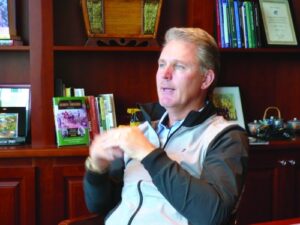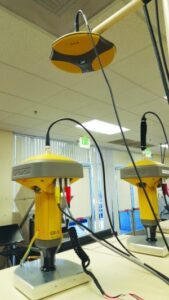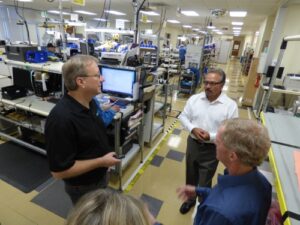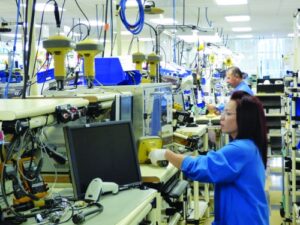
Topcon Positioning Systems’ president and CEO Ray O’Connor talks to Gavin Schrock, Editor at xyHt Magazine, about automation, integrated solutions, smart phones, golf, and the coming era of continuous representation of reality.
Ray O’Connor: I didn’t think it would take 20 years to get this far in the automation of the construction and agriculture industries. It’s been the driving vision for the company for a long time.
The two largest manufacturing industries in the world are construction and agriculture—anywhere from 7 to 10 trillion dollars worldwide—yet they are two of the least-automated industries. It was obvious that steps had to be taken in those industries in order to support the human demand from population growth.
In 1927 the world population was 2 billion; in 2012 it reached 7 billion; by 2030 it’s projected to be 8.2 billion; and by 2050, 9 billion. We have a huge problem: arable land is under pressure by commercial development. How do we grow more food on the current land that we have? If you think it’s tough right now with the infrastructure—especially here in the U.S. with so much improvement needed—then how about more infrastructure for another 1.2 billion people who will be added to the population over the next 15 years?
With these limits in the ability to take care of human growth, both in agriculture and in construction, you would expect to come up with some ways to automate. Again, I thought this would have happened faster. The tipping point was when companies like Komatsu, Caterpillar, and Deere started integrating automated systems into the equipment right in the factories. This has become common only recently, so we’re starting to see a lot of growth in that area.
In addition, I tell people all the time that the greatest catalyst to our industry was the development of the iPhone. Because it makes memory cheap, it makes extraordinary processing power and sensors widely available, it has just revolutionized such space—it has created the cloud and the ability to stream up and down in high speed. All of those things were created because of the huge application: the consumer acceptance around a device that made us all more mobile.
Looking forward in our business, there is no doubt we’ve hit the tipping point in the agriculture and construction automation segment, and there’s a huge amount of growth still ahead of us in the adoption of the instruments we make today.

Ray O’Connor: A good example would be lidar, a hot point since the ‘90s. I remember meeting Ben Kacyra [famed digital preservationist and lidar pioneer] for the first time in 1996 when we were working on producing a scanner. It was unbelievable what you could do, [but at the time] they cost way too much, and what could you do with all of the data they collected?
With devices like this [points to his iPhone] that have accelerated our ability to have more memory, more processing power, you are going to see massive changes in the business of surveying with the use of lidar. And the discussions about UAS: it is going to change surveying as we know it, absolutely change it.
Ray O’Connor: No doubt that an application [like] integrating GNSS into construction, agriculture, and surveying requires a certain amount of knowledge to get the kind of accuracies you need, like for calibrating a site. Formal education: in past interviews we chatted about how the surveyor’s role is changing. Their skills and knowledge are critically needed for contractors to automate their jobsites, so there is no doubt education is needed. As a manufacturer we look at how to make the process as simple and foolproof as operating an iPhone. How does it all become automatic in the background? We are still a ways away from that.
No doubt the adoption rate is limited. It would be different if we were going into factories, building things, and we were taking the xyz measurements to a mill or lathe and making it a CNC [computerized numerical control] machine: that is a very controlled environment. For construction, you can think of a bulldozer, and a motor grader, and all of these machines as a CNC machine—they are machining the face of the Earth—but the problem is that it is a custom job every time. They go somewhere, and they don’t always have the same employees going to the next job site with the knowledge base that’s necessary. So it takes a while for that knowledge, through osmosis, to percolate throughout the industry and for the employees to become truly comfortable.
I would say to you that where you had surveyors adapting to the change, things have gone smoother than in some areas. People’s tendency is to resist change because it does require changing their environment. There have been a lot of barriers to overcome, but the benefit is so large it’s just a matter of time.
Now, with the equipment manufacturers installing [the automation systems] at the factory, the adoption rate goes up exponentially. Folks do not really know the capabilities until it is built into the machine, integrated into the machine; from that we have seen an absolute up-tick.

Ray Vallejo took good hard look at the numbers, and they did not support the idea of outsourcing certain components and products. Vallejo is executive vice president of global operations for Topcon Positioning Systems, who has nearly three decades of experience in the management of some of the most innovative Silicon Valley companies.
His arrival at Topcon four years ago brought a retooling of production. The main facility for the production of Topcon’s GNSS, machine control, and precision agriculture control systems is co-housed at the company headquarters in Livermore, California.
“We looked at overseas outsourcing,” explained Vallejo during our tour of the facility, “but to be able to maintain the quality we demand and operate in a lean-manufacturing environment for our products, outsourcing was not the answer, nor was it less costly.”
Vallejo explained that outsourcing makes sense for certain elements of their products (tooling, castings, cables, plastics, high-volume commodity items), but for highly sophisticated, high-precision products produced on an on-demand basis, outsourcing does not fit their model.
During the tour we got a crash course in lean manufacturing: not in any way minimalist like the term might imply, but rather interwoven processes, highly monitored and controlled to avoid extraneous efforts and waste.“We have production facilities all around the world,” said Robert Kennedy, director of manufacturing, “but this particular factory was also designed to support engineering, prototyping, and pre-production.” He added, “Around this center of lean manufacturing are a lot of highly technical process, testing, and quality assurance equipment and personnel to support manufacturing, but engineering development, as well. All of this is important in the process of bringing new products to market quickly.”
Kennedy explained, “In this building, all of the activities from finance, all the way to the shipment of produced and tested equipment, is all connected through our ERP [enterprise resource planning] system. It is all connected so that at any minute of the day we can understand the status of manufacturing, the status of orders and yields, which allows us to react to orders and demand not forecasted. We can react very quickly.”
Little standing stock is kept on hand. Instead, once an order is received, many of the products can be turned around in two to three days. There are dedicated lines for products with a highly predictable volume but also lines that can be adapted and activated for several different types of product runs. Total stations are manufactured in Japan, which is the historical home for Topcon’s famed optics businesses.
“This facility is for final system integration and tests,” said Kennedy. “All of the printed circuit boards, all of the mechanical assemblies, all of the wire harnesses are done outside because they are done at qualified lower-cost manufacturing centers, and the suppliers have expertise for the specific commodities they manufacture.”
He noted that the printed circuit boards, for example, are all produced locally, less than an hour away, “so if we have any issues we can quickly respond and resolve issues. All the testing is connected though our test servers. We always want to know the status and yields; we want to monitor and analyze the parametric data that’s all collected in our system in real time.”
This expanded control of the processes is paramount for the lean manufacturing process, explained Kennedy. “There’s a lot of detailed test process of our circuit boards because that’s the heart of our systems—testing all the way from the surface mount through ICT [in-circuit tests], functional testing—and we also stress our boards with a thermal cycle. We work hard to weed out any potential early mortality or failures early in the process.”
During the process of assembly and testing, each unit goes through a burn-in cycle at 50º C and then is post-tested. The pre- and post-tests are compared: GNSS tracking, signal levels, and there is a calibration station for gyros. Antenna elements are manufactured and modeled elsewhere and then integrated at the Livermore facility. Each unit is tested as a whole unit.
Familiar-looking receivers sit on mounts at assembly and test stations. And some familiar looking-antennas are suspended, inverted above the stations with coax cables running up into the ceiling. “We have antennas on the roof, and we rebroadcast live observations indoors for testing,” said Kennedy.
The facility seems compact but not cluttered; everything has its place, and every tiny component is tracked in the system along with a full history of installation and testing and the ID of each of the team members who worked on it. One surprise was something that looked like a vending machine, but with wires, connectors, and components instead of snacks. This is a type of vendor-managed inventory for small common parts. There is also a wall that creates a unique mosaic of parts’ bins that are managed and replenished by an outside supplier with every item used entered into the same ERP system.
It is encouraging to see the inner workings of these high-precision devices: the rugged housings, the rigorous testing, and the amount of care that goes into their manufacture. But that is what we pay for: something solid and reliable that we can take for granted as we toss it into the back of our survey trucks. Kennedy pointed out the area of the factory floor that handles repairs, and that was not a busy area. Live GNSS signals are transferred from the roof of the factory via the inverted emitters above assembly and test stations.
Ray O’Connor: Obviously it was great to have the operator who could cut grade to millimeter accuracy by “the bubble in their butt,” as they would say. It was great to have that ability because the stakes were every 25’ and they had to have the skill to cut grade in between. That caliber of operator, in some cases, resisted automation because he saw a change in the value of his being able to operate a machine better than anyone else.

But we begin to see that these expert operators quickly began expanding their capabilities, as you say, as subject matter experts, to thinking: “How do I move the dirt around the entire jobsite” on a large scale, and rapidly—that becomes more important. So they learn new skills related to the job they are doing, not just the ability to cut grade (that is being done by an automated system) but also what else they need to do to speed up the process on the entire job, and consequently increase their value to the company.
I think you’re seeing that across the industry, for instance in agriculture, driving the tractor is more annoying, and a potential distraction, than anything else. The operator is thinking, “I have to drive it, and then at the same time I have to run all of the equipment behind me: the planter, the fertilizing, the sprayers [controlling] how much I’m putting on the crop and where, [and remembering] when to turn around at the end of the row.” You’re able to take the menial tasks away, and then the operator becomes a manager of the entire device and process.
It’s not unlike a machine shop; the operators running the machines have a huge skill set operating multiple machines and getting more parts out of those machines. The better operators are always more productive. So, automation is a transition of the functions that they do and where they apply their time.
Moving dirt around a jobsite is a huge skill set; to be able to move, fill in, and level an area is not just about driving a piece of machinery; it is managing where all of the material is. Why not spend more time doing that and make the machine more productive rather than worrying about how to get the blade set straight between stakes? Today you are getting 100 corrections a second on the blade of the machine.
Ray O’Connor: Absolutely. It’s where lidar was five or six years ago—not 15 years ago—these [technologies] have been adopted and continue to grow. It’s going to impact the surveying side of things: a lot of contractors turning to UAS for tasks like topo and volumes. They’re not driving around on a four-wheeler anymore [for topo]. Adding a rotor UAS is a little bit of a different application; you need to have that family of aircraft.
yHt: It seems there are a lot of consolidation and acquisitions going on in the geospatial manufacturing sector. What is Topcon’s approach when it comes to acquisitions?Everyone is going to have a fixed-wing or rotor or combinations of both. But the key is the sensors you put on board, from an accuracy standpoint, and then, really, the software. How do you take all of that data and manage the workflow? That is where you’re going to see the biggest growth in UAS. And with the connection of the software with UAS and with other sensors like scanners [you get] the ability to create 3D models rapidly and accurately.
Ray O’Connor: I thought all of the companies had been bought. [He chuckles.] Our two main competitors have bought about 150 companies between them. We do buy companies, but we try to develop capacity internally, and where we don’t have a particular technology we buy that.
But we’re not trying to grow our business typically by buying companies that have existing infrastructure, distribution, and everything; we’re not seeking position in the marketplace [purely] by volume and merging companies together. Foremost we are looking at solving a problem, and if we do not have the technology, [we consider] how we acquire that technology to become owned and guided by what it is we’re doing. We see our future as creating unique solutions for our customer.
Some recent acquisitions have been in the precision agriculture space. Back in 2006, we decided to enter into the precision agriculture business, so, for instance, we bought a small company in Australia that had unique software for variable rate control, which is a growing area in the agriculture business. We have the core sensors and machine control technology that was necessary, and we said, let’s make this small acquisition. They were doing good business and they had the [inside] knowledge of the industry. That is a very important part of entering a business: we can make devices but we need to understand the application very well.
We wanted to see what we could do in the agriculture space; it’s our fastest growing business since 2006, and as that grew we needed to acquire expertise in the business. So, we acquired Wachendorff, a company in Germany that’s the largest supplier of in-cab displays for the agriculture market worldwide. OEM is a very big part of the agriculture market, so that was a very strategic acquisition.
There was also Digi-Star, based in Wisconsin, that make the yield and weighing systems that go into combine harvesters. Again, 80% of their customers are OEMs; [the acquisition] gives us connectivity to those customers. It also gives us sensors that are now connected into the “IIOT” (we say the “Industrial Internet of Things”).
Another acquisition is Saskatchewan-based NORAC that makes the boom leveling controls for the massive sprayers, by far the leader in that technology. Every sprayer today has GPS on it, so combining those is about getting distribution of our integrated solutions through all of those customers.
This is the same for construction: people want the whole cake and not just a few slices. The full benefit of automation is often not realized unless the whole workflow can be integrated.
Ray O’Connor: I think you’re going to see UAS make an impact. I think that if you have to drive stakes in a corner, that of course would be hard to do with a UAS. [He smiles.] But, there is a lot more they could do with a UAS; it’s not just new types of hardware that will have great impact.
I think the most important part of automation that’s going to make a lot of difference for surveyors is connection to CAD for design, then to the actual automation that’s going to take place later in construction. Whether that is BIM—the building information management, and the layout inside the building, to putting the data onto a construction machine—the surveyor plays a critical role in that. Just the fact that you can operate the different equipment [that the surveyors] have from one device [controller] is a big step.
Then there is the cloud: moving data between the surveyor and design and into layout on the other end. We put telematics in our total stations; the whole idea is to provide the owner with notification of firmware updates and also get data about how the instrument is being used, management of their instrument inventories, and the anti-theft features. This is very valuable information on how we move forward, how we design instruments. We learn from the way people use them.
I think surveyors have to start looking at lidar and UAS and how they can be the experts in putting all of that data together and creating a workflow. Think of a continuous representation of reality, moving into that space.
If I put on my vision hat and think a little bit: let’s say I’m the city of Livermore or the city of San Francisco and I’ve got to manage all of those assets. Something like the IPS3 that we make, some mobile mapping device: don’t you see every bus with one of those on it driving around the city and the day-to-day changes it captures? Changes automatically captured by the software—a sign was knocked over, a pothole is getting bigger, or the lines have worn off the street—someone has to manage all of that data. For those who have to manage the infrastructure, you have to have a way to give them the information to allow them to decide what needs to get fixed today. And then to be able to easily confirm the work was indeed performed.
If you were looking at our industry, the affordability of the technology: this has such a revolutionary effect. The amount of memory is so cheap that they’re building data centers everywhere. You can’t have buses collecting 1.5 million points a second every day and not have a place to store all of that data, and then have an engine that can go through and look at what it saw yesterday and today tell me the differences.
I want to pull out any pothole larger than 12 inches because that’s where I’m going to send a crew. How are you going to know what device to manage and what to fix simply because someone called me? Wouldn’t it be more efficient to look at all of that data automatically?
To me, it’s better to have that continuous representation of reality: we’re moving into that space. Somebody has to put all of the pieces together. As manufacturers we are doing that, developing the hardware and the software, but the job opportunities for people in surveying and measurement in that space are massive!
Ray O’Connor: One of the best charts we have is from Standards & Poor’s. It shows that by 2030 the demand for infrastructure development over the world to be [over $50 trillion] and the available funds, both public and private, to be about $24 trillion. How do we solve that problem? We figure out how to be more productive.
Think of the productivity that a device like this [gestures to his iPhone] has brought to industry. You are sitting waiting for a bus in Frankfurt, and, before, you’d have to wait to get to the terminal and hook up your laptop. But now here you are waiting for the bus, and you’re productive. Now you’re able to work anywhere at any time, and the productivity that it enables us to have is exponential. We need to continue to expand the type of productivity gains that something like our smartphones has enabled to our infrastructure challenges ahead.
Ray O’Connor: I agree, and we do a lot of our educational outreach through a lot of the [geospatial programs in] schools and universities. I think there is a great opportunity, and as [professional and industry] advocates you should be pushing for that. And it should have a wide view, not just for surveying but for the whole geospatial community where training needs to take place.
We need Millennials and Gen Zers to see this as an exciting future. [Some tasks] take fewer people, and the demand is not growing. [For example,] most of the land and lots have been surveyed, and even though there will be some new lots (or lots that need resurveyed), it is not a big growth area. Property survey is essential and requires a lot of specific skills, but the reality is the surveyor who sees the growth that is coming, the opportunities and tools that have become available: there is an unbelievable future there.
Ray O’Connor: It is always frustrating when you make something new and exciting, and the biggest problem is distribution of pioneering solutions. It’s easy for me to go out and passionately convince a customer and show them where the benefits are, but how do you educate the mass market?
Usually the products are too complicated at first—the process of osmosis takes time—that is the frustration. What do you mean, the customer did not buy it? Why did they not buy it? Maybe they had one reason too many? Selling everyday products that are mature is much easier than selling pioneering products. Even for something like this [holding his iPhone], in the beginning it wasn’t easy.
I bought my first iPhone in 2007; I bought it because it was a step function in technology. I had never read an owner’s manual. It was so intuitive, so simple. [One of our dealers] was visiting here, and I was showing him the iPhone and the things it could do, and he said, “Yeah, but it’s not a good phone.” I looked at him and said, “You know, I never thought of it as a phone,” just one of the many, many functions it could do.
What was so brilliant about this is that Apple was a computer company, and what they did was take all of the applications of a powerful computer and put them simply on one device. [People] who are not adopting are not seeing the massive opportunities ahead.

We source, deploy and support intelligent positioning solutions to enhance our customers’ productivity.
Aptella Pty Ltd
ABN 56 130 367 065